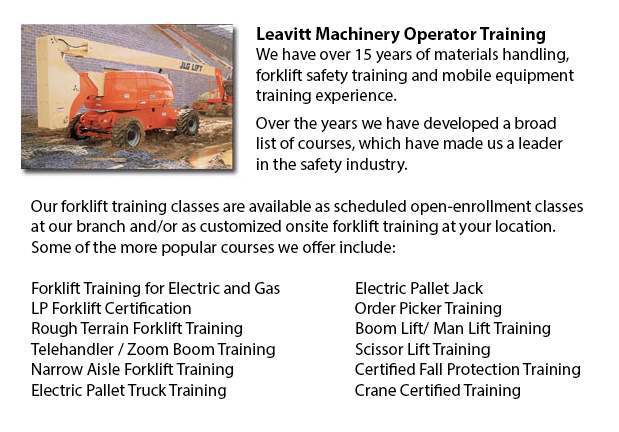
Coquitlam Manlift Training - Various manlift training programs include the review and content of manlift devices. An essential part of the program is the practicum where students demonstrate their practical ability and knowledge to operate the manlift safely. A requirement to Manlift training is the fall protection training, that can be included in the training based on the particular requirements of the customer.
Course Content
The program content comprises: pre-shift equipment inspection and work area survey requirements; the impact of performing unsafe acts or operating unsafe machinery, Lifting device equipment definitions, Review of load capabilities, the particular equipment requirements and safety decals, Review of related sections of the CSA Standards as well as the OHSA Standards and Review site specific Dangers, together with controls for safe utilization of a lifting device.
Demonstration and Evaluation Content
The demonstration and evaluation portion of the course consists of: Proper personal protective equipment or also known as P.P.E. as required; Using a spotter or a signaler when required; using a lift only on solid and level ground; Utilizing the right fitting harness or fall arrest device; Operating the lift with all other staff clear of the job place; Aware of load limits etc. and other specs as set out by the manufacturer; Having all associated machinery stored safely on the lift platform; Pre-shift work area survey and machine check; Ensuring a safe and smooth operating speed for various plant conditions and isolating off the work area when major work projects are to be done.
Each person will be tested to make sure they can efficiently and safely operate your site-specific machine.
Manlift Safety
Because the manlift is capable of lifting personnel and materials over 20 feet in the air, these machines pose a particular amount of danger and could be dangerous equipment if not used properly. As the danger is so apparent, lift owners and operators are careful to properly maintain their equipment and follow right safety precautions and operating procedures. The ratio of accidents involving this specific apparatus is fairly low.
The safe operation of the manlift, boom lift and scissor lift is up to the operator of that machine. They must know all of the responsibilities that go with operating the equipment and how to use the lift vehicle safely. The most basic safety features on the machine are safety decals and the operating manual. These show important information regarding the operating procedures, safety machines and maintenance.
Newer lift models will come along with instruction manuals and decals in place. Technically, the operating handbook must be stored on the lift itself. If you are purchasing a second-hand lift, it is essential to ensure that the manual is included and that essential decals haven't been painted over. The restraints which prevent operators from falling and the guardrails are other essential safety features. These are standard and mandatory on all types of lifts.
-
Coquitlam Crane Certification
Coquitlam Crane Certification - The Crane Certification training program consists of subject matter recommended by industry concerning the safe and efficient operation of cranes. Trainees will be taught the following: how to identify cranes and their... More -
Coquitlam Crane Training Courses
Coquitlam Crane Training Courses - A crane is a kind of equipment designed to move, lift and lower heavy stuff. A crane is usually equipped with a hoist, sheaves, and chains or wire ropes. Cranes are used in the manufacturing, construction and transp... More -
Coquitlam Boom Lift Safety Training
Coquitlam Boom Lift Safey Training - Boom lifts are a kind of elevated work platform or aerial lifting device which are usually used in industry, warehousing and construction. Boom lifts can be utilized in virtually any setting due to their versatili... More -
Coquitlam Boom Lift Training
Coquitlam Boom Lift Training - Aerial platforms or also known as elevated work platforms are devices which allow workers to carry out duties and tasks at elevated heights that would not be otherwise reachable. There are different aerial lifts availab... More -
Coquitlam Forklift Certification Schools
Coquitlam Forklift Certification Schools - Forklift Certification is mandatory within North America. Hence, forklift training programs are important both for businesses and for people looking for jobs in industries as operators of forklifts. Forklift... More -
Coquitlam Wheel Loader Training
Coquitlam Wheel Loader Training - Normally, the different types of heavy equipment training are divided into 2 categories of equipment: those that have rubber tires and tracked vehicles. Tracked vehicles include items like for instance bulldozers, ex... More -
Coquitlam Heavy Equipment Training Schools
Coquitlam Heavy Equipment Training Schools - There are a lot of heavy equipment training schools to choose from. If you would like to get to the best, it is important to examine several factors of the school to be able to determine the level of educa... More -
Coquitlam Telehandler Training Courses
Coquitlam Telehandler Training Courses - Employers are responsible for making sure that their supervisory and operating personnel are trained to work proficiently making use of telehandler equipment. The skill level of workers should be assessed. If... More

Forklift Certification Coquitlam
TOLL FREE: 1-888-254-6157
Coquitlam, British Columbia
forkliftcertificationcoquitlam.com
Email Us
About Us


